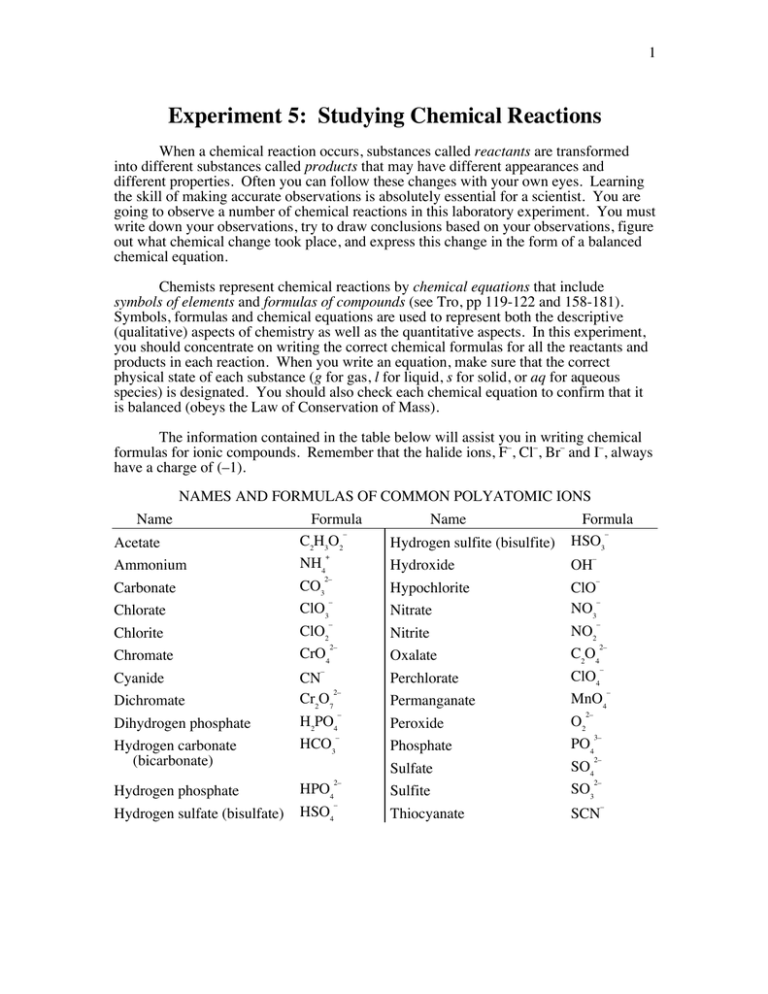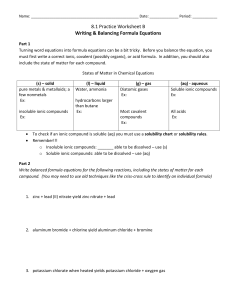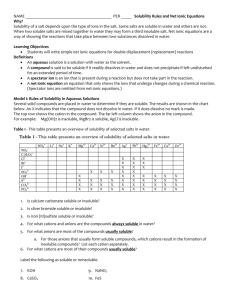Experiment 5: Studying Chemical Reactions
advertisement

1 Experiment 5: Studying Chemical Reactions When a chemical reaction occurs, substances called reactants are transformed into different substances called products that may have different appearances and different properties. Often you can follow these changes with your own eyes. Learning the skill of making accurate observations is absolutely essential for a scientist. You are going to observe a number of chemical reactions in this laboratory experiment. You must write down your observations, try to draw conclusions based on your observations, figure out what chemical change took place, and express this change in the form of a balanced chemical equation. Chemists represent chemical reactions by chemical equations that include symbols of elements and formulas of compounds (see Tro, pp 119-122 and 158-181). Symbols, formulas and chemical equations are used to represent both the descriptive (qualitative) aspects of chemistry as well as the quantitative aspects. In this experiment, you should concentrate on writing the correct chemical formulas for all the reactants and products in each reaction. When you write an equation, make sure that the correct physical state of each substance (g for gas, l for liquid, s for solid, or aq for aqueous species) is designated. You should also check each chemical equation to confirm that it is balanced (obeys the Law of Conservation of Mass). The information contained in the table below will assist you in writing chemical formulas for ionic compounds. Remember that the halide ions, F–, Cl–, Br– and I–, always have a charge of (–1). NAMES AND FORMULAS OF COMMON POLYATOMIC IONS Name Formula Name Formula – – C2H3O2 Acetate Hydrogen sulfite (bisulfite) HSO3 + – NH4 Ammonium Hydroxide OH 2– – CO3 Carbonate Hypochlorite ClO – – ClO3 NO3 Chlorate Nitrate – – ClO2 NO2 Chlorite Nitrite 2– 2– CrO4 C2O4 Chromate Oxalate – – ClO4 Cyanide CN Perchlorate 2– – Cr2O7 MnO4 Dichromate Permanganate – 2– H2PO4 O2 Dihydrogen phosphate Peroxide – 3– HCO3 PO4 Hydrogen carbonate Phosphate 2– (bicarbonate) SO4 Sulfate 2– 2– HPO4 SO3 Hydrogen phosphate Sulfite – – Hydrogen sulfate (bisulfate) HSO4 Thiocyanate SCN 2 Part A: Determining the Solubility Rules Objective: To determine the solubility rules for cations and anions by carrying out a series of chemical reactions and observing the changes that take place. Exchange reactions In exchange (or metathesis) reactions, two ionic compounds are reacted together in aqueous solution, and the resulting products reflect an exchange of the anions and cations. If one or both of the products is insoluble in water, a solid is formed which is called a precipitate. AB (aq) + CD (aq) → AD (s or aq) + CB (s or aq) (1) A series of solubility rules has been devised which allows one to predict which ionic compounds are insoluble and would form a precipitate for a given reaction. In today’s experiment, you will devise this set of solubility rules. Part B. Determining Relative Reactivities of Elements Objective: To determine the relative reactivities of copper, zinc, magnesium and hydrogen by reacting the metals with solutions of the metallic salts and hydrochloric acid. Displacement reactions Displacement reactions are a type of chemical reaction in which an element in its pure form displaces a different element from a compound in aqueous solution. A (s, l, or g) + BC (aq) → B (s, l, or g) + AC (aq) (2) These reactions are often accompanied by a color change and/or precipitate formation and/or the formation of a gas. In these reactions, electrons are transferred from the element to the cation of the compound; thus, they are a kind of reduction-oxidation, or redox, reaction. An example of a displacement reaction is: Fe (s) + Ni(NO3)2 (aq) → Fe(NO3)2 (aq) + Ni (s) Notice that the oxidation state of iron, Fe, changes from (0) to (+2), while the oxidation state of nickel, Ni, changes from (+2) to (0). We say that the iron atom has been oxidized and the nickel ion has been reduced. Whether an element reacts with a given compound depends upon which atom is more easily oxidized—the element or the cation of the compound. In equation (2), if A is more easily oxidized than B, A will react with an aqueous solution of BC. In this case, we say that A is more reactive than B. If B is more easily oxidized, a reaction between A and BC will not occur, and we say that A is less reactive than B. In this experiment, you will determine the relative reactivities of copper, magnesium, zinc and hydrogen by reacting elements in their pure form with aqueous solutions of compounds that contain the cationic form of the elements. 3 Procedure for Part A All ionic solutions are available in dropper bottles. For each reaction that you perform, place 5 drops of the first ionic solution in a small test tube (10x75 mm), then add 5 drops of the second ionic solution to the same test tube. Using a clean stirring rod (can be slightly wet with water), mix the contents of the test tube thoroughly. Write down your observations for the solutions before you have reacted them. The dropper bottles are dark brown, but you can observe the solution in the colorless dropper. Write down your observations for the mixture of the two solutions after they have been stirred together in the test tube. Observations should include whether the mixture is cloudy (precipitate present) or clear. You may also observe a color change when the solutions are mixed, and this should be noted as well. You will perform the following three groups of reactions: I. (a) (b) (c) (d) FeCl3 + CaCl2 + FeCl3 + Fe2(SO4)3 K3PO4 K3PO4 KNO3 + K3PO4 II. (a) (b) (c) (d) CuBr2 ZnBr2 CuBr2 CuSO4 NH4OH NH4OH NH4NO3 NH4OH III. (a) (b) (c) (d) + + + + NiCl2 + Na2CO3 MgCl2 + Na2CO3 NiCl2 + NaNO3 NiSO4 + Na2CO3 Dispose of any solutions or mixtures that contain nickel and/or copper in the appropriate Laboratory Byproducts jars. All other solutions may be disposed of down the sink. Choose two compounds from the following list: KOH, Cu(NO3)2, (NH4)2CO3, Na3PO4, ZnSO4 Find the bottles that contain aqueous solutions of the compounds you have chosen, and react them together as you did above (5 drops of one solution with 5 drops of the other in a test tube). Record your observations. If you have chosen the solution that contains copper, the mixture must be disposed of in the appropriate Laboratory Byproducts jar. All the other solutions are non-hazardous and may be disposed of down the sink. Procedure for Part B Metallic elements in their pure, solid form will be reacted with aqueous solutions of ionic compounds. The solutions of the compounds are available in dropper bottles. For each reaction you perform, place 10 drops of the solution in a test tube (13x100 mm), then add a piece of the pure metal. Note: You will need to sand the copper, zinc and magnesium pieces before reacting them with the solutions. 4 Write down your observations for the solutions and the metal pieces before you have reacted them. The dropper bottles are dark brown, but you can observe the solution in the colorless dropper. Write down your observations for the mixture of the solution with the metal in the test tube. Observations should include the color of the solution or mixture, whether it is cloudy (precipitate present) and whether bubbles were detected (formation of a gas). Check the mixture again 2 minutes after mixing. The aqueous solutions of the compounds provided are: CuSO4, ZnSO4, MgSO4 and HCl. The metallic elements provided are Cu, Zn and Mg. To determine the relative reactivities of the four elements, you will need to react each of the three elements provided with three compound solutions (you do not need to react an element with a compound that contains the same element). Write the necessary reactions that you will need to perform in your pre-lab assignment (there are nine). Hydrogen gas is not available for you to react with the compound solutions; however, you will be able to determine its reactivity relative to the other elements from the results of the nine reactions you perform. You must do all nine of the reactions. jar. The metal pieces must be collected in the appropriate Laboratory Byproducts 5 Questions for Part A Finish the 12 molecular equations listed under Procedure for Part A by writing the formulas for the products (do not write ionic equations). The solubility rules are derived from the following: Anions either: are generally soluble or are generally insoluble Cations either: are always soluble (overrides rule for the anion) or follow the rule of the anion For one group of reactions, I, II or III, write your answers to the following questions: 1. Note your observations for reactions (a), (b) and (c). Which products are soluble in water and which are insoluble? Explain your answer based on your observations. 2. Based on the results from reactions (a) and (b): Which anion(s) is/are generally insoluble? Explain. Which cation(s) follow(s) the rule of the anion? Explain. Which cation(s) is/are always soluble (note your observations of the solutions before mixing)? Explain. 3. Note your observations from reactions (c) and (d) in addition to (a) and (b). Which anions are generally soluble? (Hint: note your observations of both products and reactants.) Explain. 4. You will need to answer these questions for the other two groups of reactions, and then compile your results from all three groups to list: • which anions are generally soluble • which anions are generally insoluble • which cations are always soluble • which cations follow the rule of the anion. 5. Complete the 12 molecular equations that you wrote above by balancing them and including the physical state (s, l, g or aq) of each reactant and product in the equation. Follow the format of Equation (1) found in the Introduction. 6. Using your solubility rules, predict what would be observed if the two compounds that you selected from the list are reacted together. Explain. Does this prediction match your observation? Write the balanced chemical equation for the reaction, including the physical state of each reactant and product. 6 Questions for Part B 1. List the four elements in decreasing order of reactivity, citing the experimental evidence that supports your order. Most reactive > … > … > Least reactive 2. Write balanced chemical equations for all reactions that occurred (include the physical states). Follow the format of Equation (2) found in the Introduction. You do not need to write equations in the cases of reactions that did not occur. Remember, the element hydrogen is a gas with the chemical formula H2. Note: You may have observed bubbles in some of the reactions which did not involve HCl. These bubbles are the result of a very small amount of H+ ion present in the metal salt solution. You may ignore these bubbles when writing the equations; that is, do not include H2 gas in the equations for reactions which do not involve HCl. 3. Zinc metal, Zn, will react with cobalt sulfate, CoSO4. Will cobalt, Co, react with magnesium sulfate, MgSO4? If so, write a balanced chemical equation. Will magnesium, Mg, react with cobalt sulfate, CoSO4? If so, write a balanced chemical equation. Explain.






